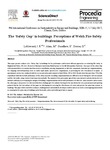The ‘Safety Gap’ in buildings: Perceptions of Welsh Fire Safety Professionals
| dc.contributor.author | Littlewood, JR | |
| dc.contributor.author | Alam, M | |
| dc.contributor.author | Goodhew, Steve | |
| dc.contributor.author | Davies, G | |
| dc.date.accessioned | 2018-07-30T10:09:19Z | |
| dc.date.available | 2018-07-30T10:09:19Z | |
| dc.date.issued | 2017-10 | |
| dc.identifier.issn | 1876-6102 | |
| dc.identifier.uri | http://hdl.handle.net/10026.1/11947 | |
| dc.description.abstract |
This paper presents evidence of a 'Safety Gap' in buildings for fire performance and reviews different approaches to achieving Fire safety in England and Wales, UK, for a Research & Enterprise Innovation Funded project at Cardiff Metropolitan University. One aspect of the safety Gap is for potential defects in construction from incorrect installation, missing, inappropriate or defective components, that make up compartmentation, fire stoppings and workmanship errors, to enable rapid smoke spread across compartments, so preventing the safe evacuation of occupants. A questionnaire survey was conducted with fire rescue and safety professionals in South Wales, UK in 2016. Results show that more than 75% of the respondents think that in-built performance of fire safety measures including compartmentation are difficult to assess during fire risk assessments and fire risk audits, using current visual inspection methods. The majority of the participants agreed that a non-intrusive and non-destructive test method could help in ascertaining the integrity of building compartmentation and in-built performance of other fire safety measures and to ensure the safety gap is not present. It is discussed that these findings give fire industry backing for the non-destructive test, measurement and reporting protocol that the first two authors of this paper are developing for assessing the effectiveness of active and passive fire protection systems in buildings. This paper will be useful for academics, building owners and landlords, developers and fire and rescue services investigating and involved in ensuring the fire protection of buildings and of the health, safety and wellbeing of their occupants. . | |
| dc.format.extent | 787-796 | |
| dc.language.iso | en | |
| dc.publisher | Elsevier BV | |
| dc.subject | Safey Gap | |
| dc.subject | Fire safety measures - Compartmentation | |
| dc.subject | Fire risk assessment & fire risk audit | |
| dc.subject | Occupant safety and wellbeing | |
| dc.title | The ‘Safety Gap’ in buildings: Perceptions of Welsh Fire Safety Professionals | |
| dc.type | conference | |
| dc.type | Conference Proceeding | |
| plymouth.author-url | https://www.webofscience.com/api/gateway?GWVersion=2&SrcApp=PARTNER_APP&SrcAuth=LinksAMR&KeyUT=WOS:000426694800080&DestLinkType=FullRecord&DestApp=ALL_WOS&UsrCustomerID=11bb513d99f797142bcfeffcc58ea008 | |
| plymouth.volume | 134 | |
| plymouth.publication-status | Published | |
| plymouth.journal | Energy Procedia | |
| dc.identifier.doi | 10.1016/j.egypro.2017.09.586 | |
| plymouth.organisational-group | /Plymouth | |
| plymouth.organisational-group | /Plymouth/Faculty of Arts, Humanities and Business | |
| plymouth.organisational-group | /Plymouth/Faculty of Arts, Humanities and Business/School of Art, Design and Architecture | |
| plymouth.organisational-group | /Plymouth/REF 2021 Researchers by UoA | |
| plymouth.organisational-group | /Plymouth/REF 2021 Researchers by UoA/UoA13 Architecture, Built Environment and Planning | |
| plymouth.organisational-group | /Plymouth/Users by role | |
| plymouth.organisational-group | /Plymouth/Users by role/Academics | |
| dc.rights.embargoperiod | Not known | |
| rioxxterms.versionofrecord | 10.1016/j.egypro.2017.09.586 | |
| rioxxterms.licenseref.uri | http://www.rioxx.net/licenses/all-rights-reserved | |
| rioxxterms.type | Conference Paper/Proceeding/Abstract |


